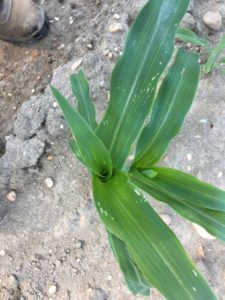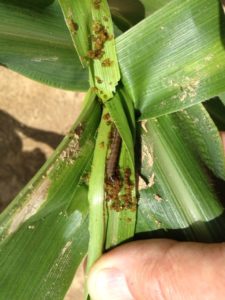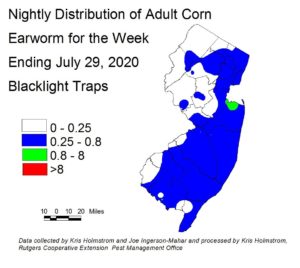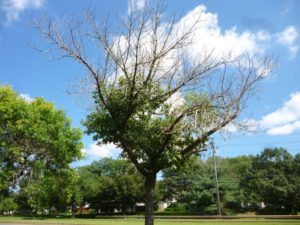Sweet Corn
European corn borer (ECB) adults continue to be very low, although a few traps in Cape May and Burlington counties have shown initial signs of a second flight. Numbers are low and isolated such that no map will appear in this edition.
The highest nightly trap catches of ECB for the week ending 7/29/20 are as follows:
| Eldora 2 | Downer 1 |
| Cinnaminson 1 | Medford 1 |

 Fall armyworm (FAW) larval infestations are generally low, but IPM technicians report more frequent occurrences in the central counties. This is the time of the summer when FAW can show up, resulting in significant injury to whorl and even seedling stage corn. Injury from newly hatched larvae shows up as “window panes” or areas where leaf tissue has been eaten down the the lower epidermis (see photo at far left). This injury leads down into the whorl. As larvae gain size, they begin to consume leaf tissue in its’ entirety, creating ragged holes and lots of droppings (see photo at near left). FAW can be tough to manage because it is resistant to synthetic pyrethroid insecticides (IRAC 3A) and because larvae are often covered by their own droppings, making contact with the insecticide more difficult. Treat when 12% or more plants exhibit FAW injury alone, or in combination with ECB injury.
Fall armyworm (FAW) larval infestations are generally low, but IPM technicians report more frequent occurrences in the central counties. This is the time of the summer when FAW can show up, resulting in significant injury to whorl and even seedling stage corn. Injury from newly hatched larvae shows up as “window panes” or areas where leaf tissue has been eaten down the the lower epidermis (see photo at far left). This injury leads down into the whorl. As larvae gain size, they begin to consume leaf tissue in its’ entirety, creating ragged holes and lots of droppings (see photo at near left). FAW can be tough to manage because it is resistant to synthetic pyrethroid insecticides (IRAC 3A) and because larvae are often covered by their own droppings, making contact with the insecticide more difficult. Treat when 12% or more plants exhibit FAW injury alone, or in combination with ECB injury.
 Corn earworm (CEW) moth captures have remained largely unchanged in blacklight traps this past week. This moderate mid-Summer population poses a significant risk to silking corn. Blacklight catches were highest overall along the Atlantic coast (see map at left), with blue areas on this map representing a 4-5 day spray schedule.
Corn earworm (CEW) moth captures have remained largely unchanged in blacklight traps this past week. This moderate mid-Summer population poses a significant risk to silking corn. Blacklight catches were highest overall along the Atlantic coast (see map at left), with blue areas on this map representing a 4-5 day spray schedule.
The highest nightly trap catches of CEW in black light traps for the week ending 7/29/20 are as follows:
| Denville 2 | Crosswicks 1 | Hackettstown 1 |
| Jones Island 2 | East Vineland 1 | Medford 1 |
| Matawan 2 | Elm 1 | New Egypt 1 |
| Allamuchy 1 | Green Creek 1 | Tabernacle 1 |


